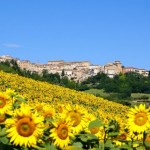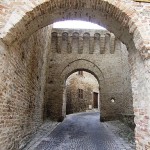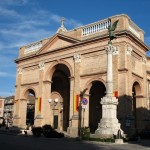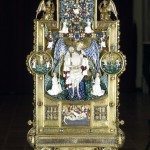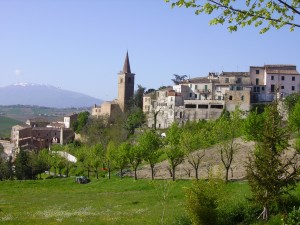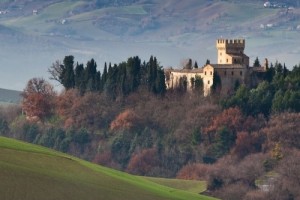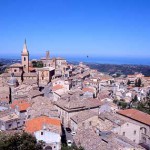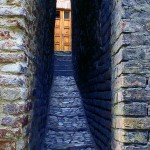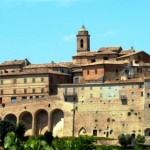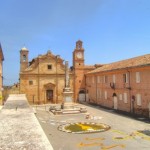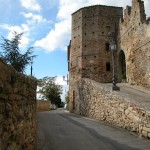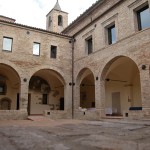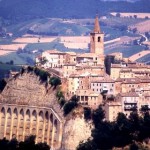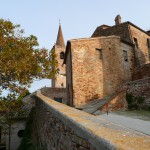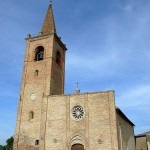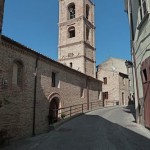The route is dedicated to the principal villages in the suggesting calanchi’s landscape. The calanchi were created by the erosion of water. The route includes some beautiful medieval villages: Montalto delle Marche, Patrignone, Carassai, Ripatransone, Montefiore dell’ Aso, Castignano.
MEETING POINT: Sisto V Square, Montalto delle Marche
DURATION: 6 hours, full day
TRANSPORT: walking route,bus or car for long travelling
Extra costs could be expected to enter into some sites
NOTES: The route could be changed according yours demands
The route starts in Montalto delle Marche; this village is linked to the Pope Sisto V: he was born in Grottammare and he studied in Montalto delle Marche where his family came from. Montalto delle Marche became the seat of the Diocese and capital of the same Presidato thanks to Pope Sisto V in 1586. The medieval arrangement was adapted to a new project: it was realized by the famous architect Domenico Fontana. Pope Sisto V died and this project didn’t realize. Montalto delle Marche is composed by two parts: the superior part is characterized by Umberto I Square with the monument dedicated to the architect Giuseppe Sacconi. In this square you can find the Preside Palace built thanks to Pope Sisto V in 1586, Orlandi House (XVI century) where Peretti Family (the Pope’s family) lived and the Baroque facade of the Church of S. Nicolò. Of great interest are the museums in the square: the Archeological Museum, the “Museum of the water, the earth and the canvas”, the Art Gallery.
The inferior part of the village is characterized by Sisto V Square: here we can find the Seminary, the Cathedral dedicated to the Assunta. The inferior part of the church conserves the Bishops’ tombs. In the Seminary you can visit the Sistine Museum, full of mastepieces: among them you can find the Reliquary donated to the Cathedral thanks to Sisto V in 1586; it is an extraordinary example of Parisian gold art in golden silver, varnishes and precious stones.
Not far from Montalto delle Marche you can find the Church of S. Agostino (XIII-XIV century): it was part of a Benedictine complex. You can find the convent of S. Francis to the Fratte (XIII century): once a medieval crucifix was here; today it is conserved in the Sistine Museum. Of great interest, along Vaso Valley, is the mill-tower called “The mill of Sisto V” (XVI century)
- Montalto delle Marche
- Patrizia Gateway
- Cathedral ofS. Maria Assunta
- Reliquary of Sisto V
Not far from Montalto you can visit Patrignone. Here very important personalities were born: among them Antonio Bonfini, the famous humanist. He studied in Ascoli Piceno, he went in Ungheria and the King Mattia Corvino ordered him to write the History of Ungheria. Another important person was the artist Desiderio Bonfini. Patrignone mantains its original and medieval defence arrangement: still today you can see the towers and the medieval walls of the XIII century.Of great interest is the Church of S. Mary in Viminatu, of Romanesque and Gothic architecture. It is full of frescoes with a tabernacle in golden and engrave wood made by Desiderio Bonfini. In Patrignone you can find Bonfini Palace in Bonfini Square and an interesting example of the Baroque architecture is the rural church of S. Mary of Graces, called Madonna Tonna for its octagonal form.
We are visiting Carassai: still today you can see two different parts. One of them of the IX century and the second part of the XIII century. The ancient part is called “Old Castle” and here you can see the Mountain Gateway. The second part is the “New Castle”: it conserves the traces of “fovee”, the storages of wheat in the XVI century. You can visit the Collegiata of Good Jesus (1788) with precious frescoes made by Boscoli and Pauri, disciple of Adolfo De Carolis. Not far from Carassai we can admire the Montevarmine Fortress with its medieval battlements. It was built during the Langobard period probably. The fortress is one of the few example of great fortify farms in the Piceno territory; behind its walls, in 1871, the “bombardella manesca” was discovered. The “bombardella manesca” is the most ancient firearm. In this territory you can find many churches: the Church of S. Angelo in Piano, the Church of S. Pietro in the Castle, the Church of S. Luca.
In Ripatransone you can find numerous churches: the most important of them is the Church of S. Gregorio and Margherita (XVI-XVII century). In this village you can see beautiful buildings such as Massi-Mauri Palace with a particular aspect and anelegant balcony in wrought iron (XVIII century), the Podestà Palace (1307), the Town Hall (XIII century) and two theaters: the Luigi Mercantini Theater and “The Fonti” complex where an ample outdoor space has been set up for concerts. In Ripatransone you can pass through the narrowest lane in Italy (43 centimeters)
- Ripatransone, the Overlook of the Piceno territory
- The narrowest lane in Italy, Ripatransone.
Montefiore dell’Aso is located between Aso and Menocchia Valleys. According to tradition the name of the village derives from Flora divinity; nearby Montefiore you can find Montefiore and Aspramonte Castles; the walls of the XV century are conserved perfectly. Of great interest is the Church of S. Francis: the funerary monument of Cardinal Partino‘s parents is conserved. In the church you can admire the frescoes dedicated to Jesus Christ made by Master of Offida (XIV century) and the tomb of Adolfo De Carolis. Montefiore is full of churches: these churches were built between the XVI and the XVII century thanks to the numerous holy orders: the Church of S. Domenico, the Church of S. Filippo Neri, the Church of S. Mary of the Faith, the Church of S. Mary of Graces and the Church of S. Johannes the Baptist. During the XVIII century the Collegiata was built thanks to nobles families and holy orders: in this church the polyptych of Carlo Crivelli is conserved.
A great person in Montefiore dell’Aso was the painter and the engraver Adlfo De Carolis; he illustrated Pascoli and D’Annunzio’s books. In Montefiore a rich collection of sketches and drawings is conserved
- Montefiore dell’Aso
- Montefiore dell’Aso
- The fortified tower, Montefiore dell’Aso
- The Museum of S. Francesco, Montefiore dell’Aso
Castignano rises up at the foot of Ascensione Mountain; its name derives from the presence of a chestnut wood. In Castignano a particular type of anise is cultivate: the green anise used for the production of the famous liqueur Anisetta Meletti. Castignano has an ancient origin as you can see in the stone tablet of Castignano with a Picenum inscription (VI century B.C): one of the most ancient example of Picenum writing.
At the top of the village you can see the Church of SS. Peter and Paul: it was built in the XI century but it has a Romanesque structure of the XIV century. In this church you can admire the great fresco which represents the “Crack of Doom” (XV century)
The Templars were in Castignano: every year a festival hold in Castignano in remembrance of the passage of the order of the Templars. An example of this passage is the Church of S. Mary in Borgo (called Templars’ Church): its portal presents geometric ornaments and a tile with the symbol of the order of the Templars. Another interesting church is the Church of S. Egidio (XVII century): in the church you can admire precious works of art such as the Madonna of the Rosary made by Simone De Magistris and the reliquary-monstrance of the Holy Cross (XV century): in this reliquary a part of the Chirst’s cross is conserved; it is donated by Pope Niccolò IV. The most interesting buildings are along Margherita Street, the main street of the historical centre of Castignano where you can find residences of the XVI and the XVII century
- Castignano
- Castignano
- The Church of SS. Pietro and Paolo
- The Church of S. Maria in Borgo
- Templaria festival


